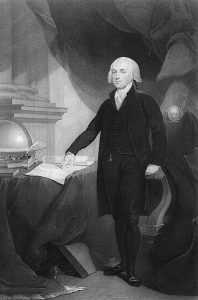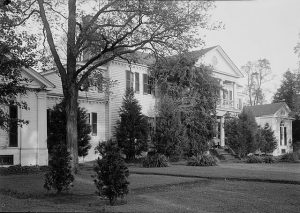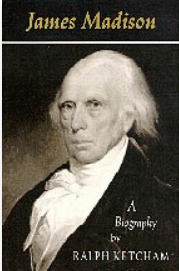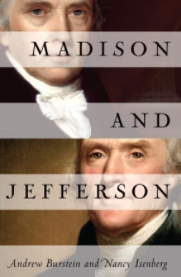James Madison
James Madison Biography
Overview

Picture File Source (2)
Madison was an American statesman, diplomat, expansionist, philosopher, and Founding Father who served as the fourth president of the United States from 1809 to 1817. He is hailed as the “Father of the Constitution” for his pivotal role in drafting and promoting the Constitution of the United States and the United States Bill of Rights. He co-wrote The Federalist Papers, co-founded the Democratic-Republican Party, and served as the fifth United States Secretary of State from 1801 to 1809. (1)

Belle Grove Plantation near Port Conway in the Colony of Virginia
Quick Facts:
| Full Name | James Madison |
| Birth Date | March 1, 1751 |
| Birth Place | Port Conway, VA |
| Death Date | June 28, 1836 |
| Career | Politician, Planter |
| Spouse | Dolley Payne (Sept. 15,1794) |
| Children | None |
| President No. | 4 |
| Presidency Begin | March 4, 1809 |
| Presidency End | March 4, 1817 |
| Vice President(s) | George Clinton (1809–12) None (1812–1813) Elbridge Gerry (1813–14) None (1814–1817) |
James Madison Jr. was born on March 16, 1751, (March 5, 1750, Old Style) at Belle Grove Plantation near Port Conway in the Colony of Virginia, to James Madison Sr. and Nelly Conway Madison. His family had lived in Virginia since the mid-1600s.[1] Madison grew up as the oldest of twelve children, with seven brothers and four sisters, though only six lived to adulthood. His father was a tobacco planter who grew up on a plantation, then called Mount Pleasant, which he had inherited upon reaching adulthood. With an estimated 100 slaves and a 5,000 acres (2,000 ha) plantation, Madison’s father was the largest landowner and a leading citizen in the Piedmont. Madison’s maternal grandfather was a prominent planter and tobacco merchant. In the early 1760s, the Madison family moved into a newly built house that they named Montpelier. (20)
In 1774, Madison took a seat on the local Committee of Safety, a pro-revolution group that oversaw the local Patriot militia.[40] In October 1775, he was commissioned as the colonel of the Orange County militia, serving as his father’s second-in-command until his election as a delegate to the Fifth Virginia Convention, which was charged with producing Virginia’s first constitution.[41] Even though Madison was of short stature, 5 Feet 4 inches, and was frequently in poor health, He never saw battle in the Revolutionary War, but rose to prominence in Virginia politics as a wartime leader.[42]
When the Virginia constitution was enacted, Madison became part of the Virginia House of Delegates and then elected into the Governor’s Council of State. [43] While serving here Madison became close to the Governor, Thomas Jefferson. [44]
In 1787, while Madison was waiting for a quorum to assemble at the Constitutional Convention he drafted the Virginia Plan, which became the blueprint for the U.S. Constitution. This plan proposed a central government with three branches that would check and balance each other, keeping any one branch from wielding too much power.
In 1789, Madison was elected to the US House of Representatives and served as Washington’s chief supporter [240]. Initially he believed that the Bill of Rights was not only unnecessary but dangerous because it would make it look like some rights were specifically given while others were not. [241]. He only go on board with the Bill of Rights when it looked like the Constitution would not be ratified by the states without it. [242] After studying over 200 amendments that had been proposed during the state ratifying conventions, he introduced the Bill of Rights on June 8, 1789. [243] His amendments contained numerous restrictions to the Federal government and would protect, freedom of religion, speech and the right to peaceful assembly. [244] Of the 12 amendments that were formally proposed by Congress to the states, 10 of them were ratified as additions to the Constitution on December 15, 1791, becoming known as the Bill of Rights. [245].
In 1774, Madison took a seat on the local Committee of Safety, a pro-revolution group that oversaw the local Patriot militia.[40] In October 1775, he was commissioned as the colonel of the Orange County militia, serving as his father’s second-in-command until his election as a delegate to the Fifth Virginia Convention, which was charged with producing Virginia’s first constitution.[41] Even though Madison was of short stature, 5 Feet 4 inches, and was frequently in poor health, He never saw battle in the Revolutionary War, but rose to prominence in Virginia politics as a wartime leader.[42]
When the Virginia constitution was enacted, Madison became part of the Virginia House of Delegates and then elected into the Governor’s Council of State. [43] While serving here Madison became close to the Governor, Thomas Jefferson. [44]
In 1774, Madison took a seat on the local Committee of Safety, a pro-revolution group that oversaw the local Patriot militia.[40] In October 1775, he was commissioned as the colonel of the Orange County militia, serving as his father’s second-in-command until his election as a delegate to the Fifth Virginia Convention, which was charged with producing Virginia’s first constitution.[41] Even though Madison was of short stature, 5 Feet 4 inches, and was frequently in poor health, He never saw battle in the Revolutionary War, but rose to prominence in Virginia politics as a wartime leader.[42]
When the Virginia constitution was enacted, Madison became part of the Virginia House of Delegates and then elected into the Governor’s Council of State. [43] While serving here Madison became close to the Governor, Thomas Jefferson. [44]
After two terms in office, Madison left Washington, D.C., in 1817, and returned to Montpelier with his wife. Despite the challenges he encountered during his presidency, Madison was respected as a great thinker, communicator and statesman. He remained active in various civic causes, and in 1826 became rector of the University of Virginia, which was founded by his friend Thomas Jefferson. Madison died at Montpelier on June 28, 1836, at the age of 85, from heart failure. (220)
Resources
Web Sites:
Books:
REFERENCES
- (1) https://en.wikipedia.org/wiki/James_Madison
- (2) James Madison Portrait- File:James Madison Portrait2.jpg. (2017, September 25). Wikimedia Commons, the free media repository. Retrieved 12:49, June 16, 2021 from https://commons.wikimedia.org/w/index.php?title=File:James_Madison_Portrait2.jpg&oldid=259822974.
- (3) Belle Grove – Library of Congress, Public domain, via Wikimedia Commons
- (20) https://en.wikipedia.org/wiki/James_Madison#Early_life_and_education)
- (40) Stagg, J.A., ed. (October 4, 2016). “James Madison: Life Before the Presidency”. Univ. of Virginia Miller Center. Retrieved February 14, 2017.
- (41) Wills, Garry (2005). Henry Adams and the Making of America. Houghton Mifflin. ISBN 978-0-618-13430-4. , pp. 12–13
- (42) Burstein, Andrew; Isenberg, Nancy (2010). Madison and Jefferson. Random House. pp. 14–15
- (43) Burstein, Andrew; Isenberg, Nancy (2010). Madison and Jefferson. Random House. pp. 48-59, 59-60
- (44) Burstein, Andrew; Isenberg, Nancy (2010). Madison and Jefferson. Random House. pp. 65–66
- (220) https://www.history.com/topics/us-presidents/james-madison
- (240) • Montpelier : https://www.montpelier.org/learn/the-life-of-james-madison
- (241) • Montpelier : https://www.montpelier.org/learn/the-life-of-james-madison
- (242) • Montpelier : https://www.montpelier.org/learn/the-life-of-james-madison
- (243) Burstein, Andrew; Isenberg, Nancy (2010). Madison and Jefferson. Random House. – pp. 197-199
- (244) • Feldman, Noah (2017). The Three Lives of James Madison: Genius, Partisan, President. Random House. ISBN 978-0-8129-9275-5. pp. pp. 267-269
- (245) “The Charters of Freedom: The Bill of Rights”. National Archives and Records Administration. October 31, 2015. Retrieved February 16, 2017.



